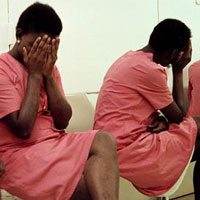148 California Female Prison Inmates Were Illegally Sterilized

California regularly sterilized women in institutions for much of the 20th century before deciding that having a eugenics program that inspired Nazis in Germany probably wasn’t a good thing and essentially banned the practice.
Or so the public was led to believe.
At least 148 women in two California prisons were sterilized between 2006 and 2010 in violation of prison rules and several federal and state laws, according to the Center for Investigative Reporting (CIR). And there could be another 100 dating back to the 1990s.
Pregnant women at the California Institution for Women in Corona and Valley State Prison for Women in Chowchilla were signed up for the sterilization procedure. While there are allegations that the women were overtly coerced, the laws that set up a process for approving sterilization of prisoners, the poor and the mentally ill, which was ignored, assume that incarcerated people are automatically acting under duress.
Dr. James Heinrich, Valley State Prison’s OB-GYN in 2006, explained to CIR why prison sterilization made sense (after being told the doctors were paid $147,460 by the state), “Over a 10-year period, that isn’t a huge amount of money compared to what you save in welfare paying for these unwanted children—as they procreated more.”
The state clamped down on forced sterilization in 1979, and in 1994 passed a law that requires a detailed approval process in prisons for “surgery not medically necessary,” including penal implants, vasectomies, breast reductions and tubal ligations. The federal government forbids use of its funds for sterilization, so California was forced to use its own when operating on women.
Although, judging by the widespread response in the media to CIR’s story last week, the public is surprised by the continued use of sterilization, lawmakers shouldn’t be. Justice Now, a prisoner rights group, complained to state Senator Carol Liu in 2010 about information it had concerning the continued use of sterilization. Liu’s office reportedly complained to the prisons’ Health Care Review Committee, which apparently then told the prisons to cut it out.
Dr. Ricki Barnett, who has led the committee since 2008, told CIR that doctors seemed to have no idea that the sterilizations were banned. “Everybody was operating on the fact that this was a perfectly reasonable thing to do,” she said.
In March 2012, Justice Now outlined (pdf) for a state Senate subcommittee a laundry list of ongoing prison abuses that included sterilizations during labor and delivery.
Justice Now Executive Director Cynthia Chandler wrote the committee that sterilizations had been illegally performed in state prisons since 2006 when the Gender Responsive Commission of the California Department of Corrections and Rehabilitation (CDCR) proposed that sterilizations be redefined as “medically necessary” to circumvent the law. “Over 150 tubal ligations have been performed by CDCR medical partners during labor and delivery on people in women’s prisons since 2006, beginning one month after the recommendation to begin this practice was presented to the Gender Responsive Commission,” Chandler wrote.
California was in the forefront of a national movement for forced sterilization in the early part of the 20th century. Under the state’s 1909 sterilization law, at least 20,000 Californians in state hospitals and prisons were involuntarily sterilized by 1964.
Sterilization was part of the “scientific” movement called eugenics, which aims to improve the genetic composition of a population by manipulating its genetic composition. The movement, which had its first early successes in the United States, became a centerpiece of Adolph Hitler’s Nazi political movement in Germany. Three notables in the eugenics movement were California Board of Corrections and Charities members: Rabbi Martin Meyer (1911-1920); Rabbi Rudolph Coffee (a founding member of the Human Betterment Foundation and a board member from 1924-1931), and John Randolph Haynes, M.D. and Ph.D. (1912-1923).
Early on, men were as likely to be sterilized as women, but by the 1940s women were almost the total focus. The mentally ill, the disabled, the poor and minorities were all targets of the movement.
–Ken Broder
To Learn More:
Female Inmates Sterilized in California Prisons without Approval (by Corey G. Johnson, Center for Investigative Reporting)
In Chilling Nod to Eugenics, Doctors Illegally Sterilized California Prisoners (by Sarah Lazare, Common Dreams)
Female Inmates in California Prisons Sterilized Without Approval (by Laura Sesana, Washington Times)
Letter on Sterlilization to the Senate Budget and Fiscal Review Subcommittee (Justice Now) (pdf)
A California Prison Proposal That is Disturbingly Akin to Eugenics (by Robin Levi and Vanessa Huang, Justice Now)
North Carolina Agrees to Compensate Sterilized Welfare Recipients (by Noel Brinkerhoff and David Wallechinsky, AllGov)
Giving Birth in Prison (by Kyle Kuersten, AllGov)
- Top Stories
- Controversies
- Where is the Money Going?
- California and the Nation
- Appointments and Resignations
- Unusual News
- Latest News
- California Forbids U.S. Immigration Agents from Pretending to be Police
- California Lawmakers Urged to Strip “Self-Dealing” Tax Board of Its Duties
- Big Oil’s Grip on California
- Santa Cruz Police See Homeland Security Betrayal in Use of Gang Roundup as Cover for Immigration Raid
- Oil Companies Face Deadline to Stop Polluting California Groundwater





